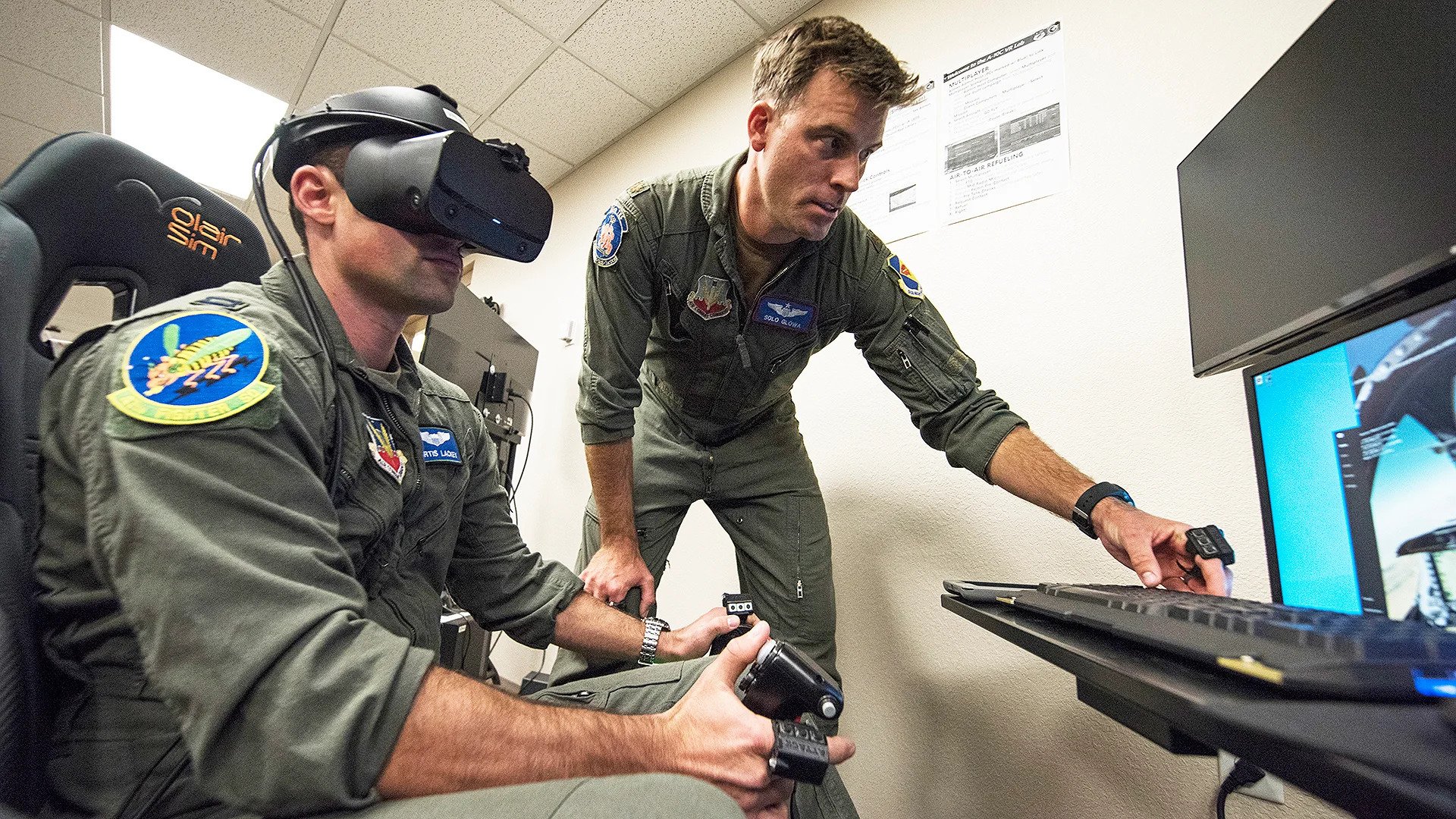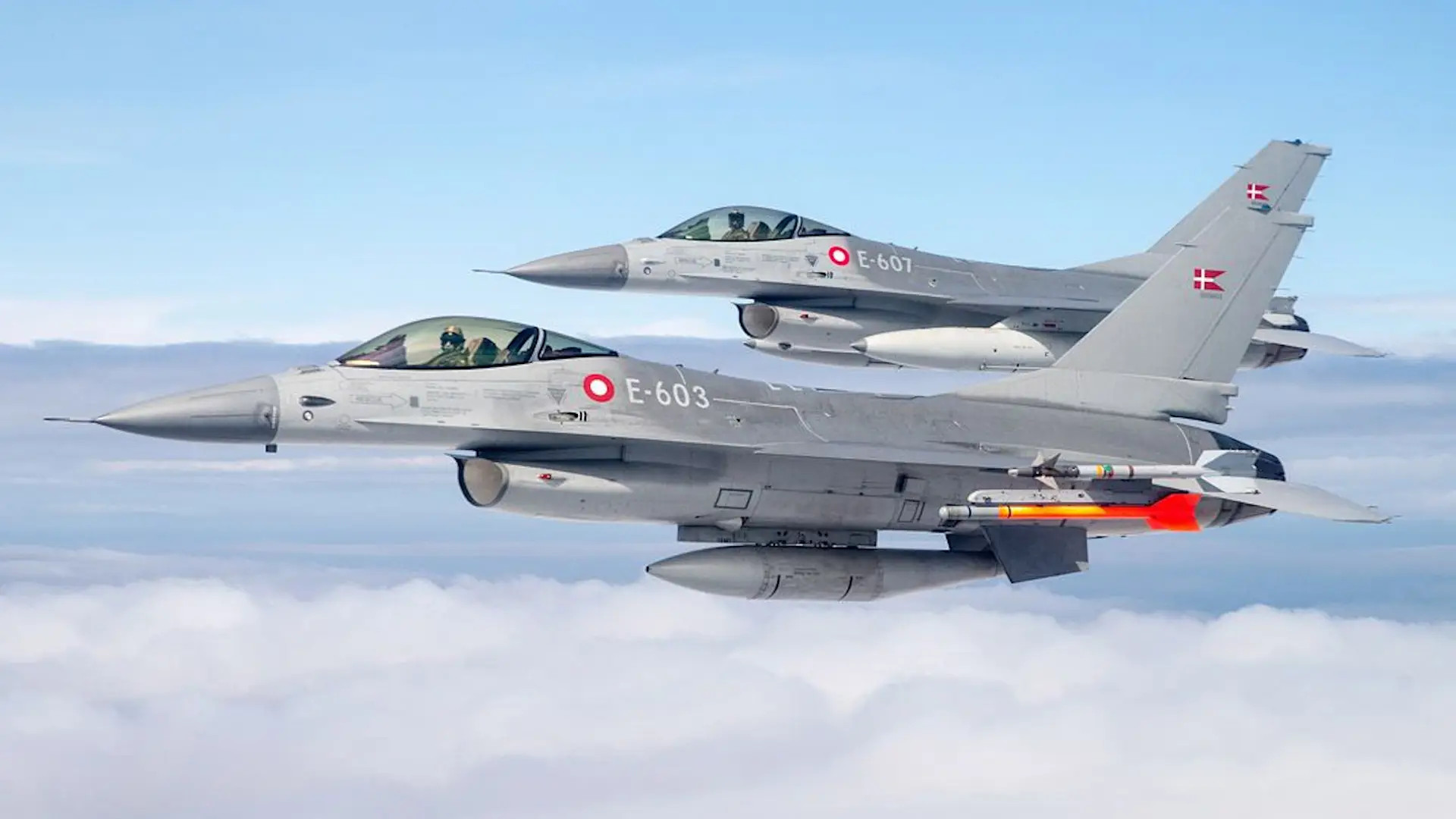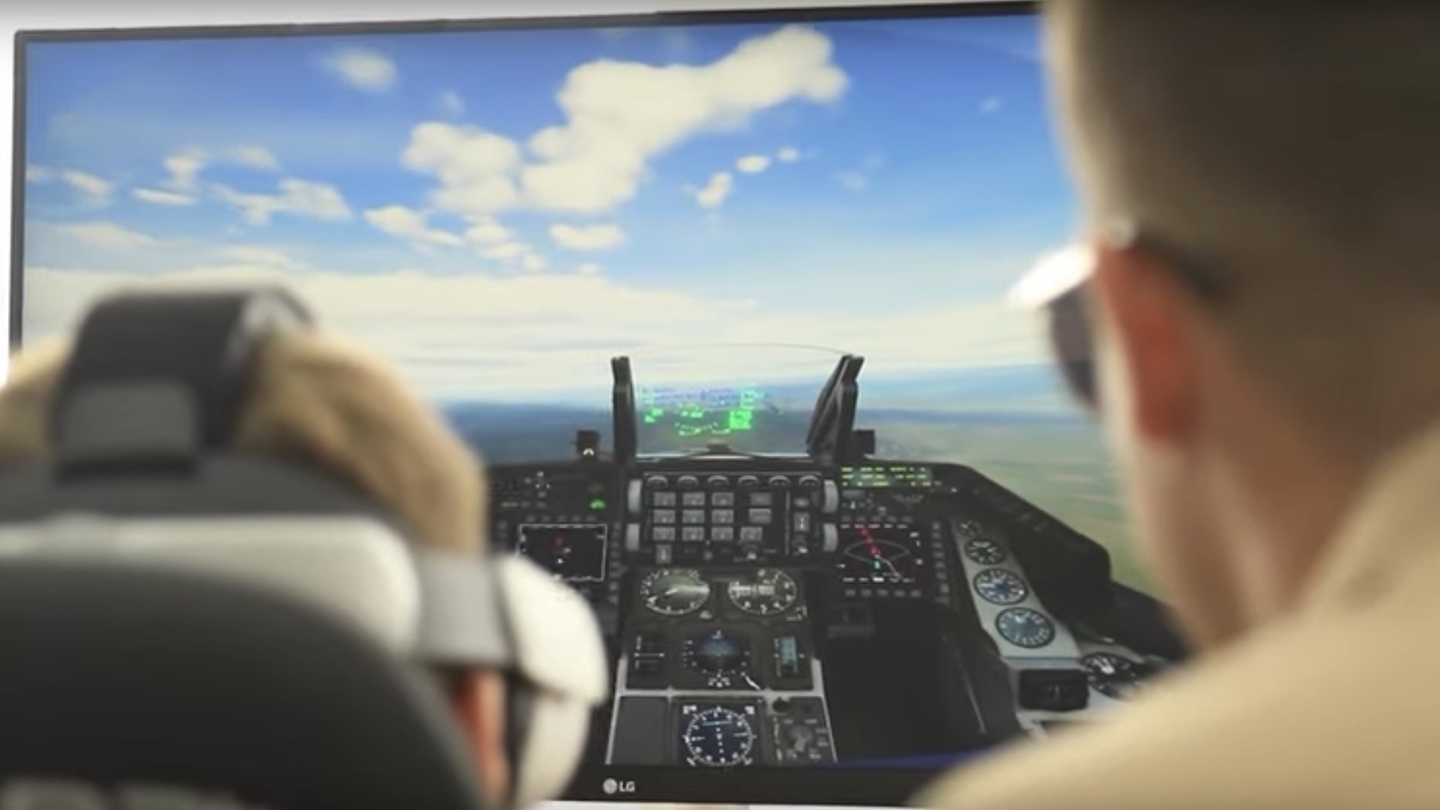Ukraine’s Air Force is not waiting for training programs taking place outside the country to begin the process of familiarizing its pilots on the F-16 Viper. It is jump-starting that training at its bases across the country.
When they aren’t taking to the skies in their Soviet-designed Su-27 Flankers and MiG-29 Fulcrums against Russian targets, Ukrainian pilots are spending some of their spare moments flying virtual reality (VR) F-16 simulators.

“All of us understand the future belongs to F-16 aircraft, or the other aircraft which our partners will provide us with,” Adrii, a young Ukrainian fighter pilot sitting in the cockpit of his Flanker says in a video released Wednesday by the Ukrainian Air Force. “That’s why we need to train now, learn the cockpit equipment, armament system and its employment.”
Then with a big smile, Adrii says he will show viewers what it is like to fly the simulator, which consists of a VR headset, control stick, throttle, pedals and a screen showing the simulated flight in progress so instructors can help guide the student.
There are some major differences between the Viper and Flanker beyond performance, chiefly the cockpit interfaces and basic concept of operations. Andrii noted that the Viper is controlled by a sidestick to the pilot’s right instead of a control column in the middle.
The software being used is Digital Combat Simulator: World (DCS) running the F-16C module. These are similar to the DCS-based systems used at home by many enthusiasts as well as by U.S. Air Force’s A-10 Warthog pilots at the 355th Training Squadron at Davis-Monthan Air Force Base in Arizona. It’s part of a low-cost way to augment aerial training. Last year, a Ukrainian infantryman managed to crowdfund development of a secret A-10 Warthog simulation training center similar to the one at Davis-Monthan. You can read more about that in our story here.

The F-16 simulators have been placed at all Ukrainian tactical aviation brigades so that pilots can familiarize themselves enough with the F-16 to shorten their time training outside the country, said Oleksii Diakiv of the Ukrainian Air Force Training Command.
As we have reported before, training for Ukrainians in language and operational skills is already taking place in the U.K, and Denmark, with many other countries pledging to take part as well. Training will also soon begin in the U.S., the Pentagon’s top spokesman told reporters last week.

“We do expect Ukrainian pilots and maintainers to arrive in the United States soon to conduct the initial English language training, and then the pilot training to start in the in the weeks after that,” said Air Force Brig. Gen. Pat Ryder.
At the recent Air and Space Forces Association conference at National Harbor, Maryland, Air National Guard, Air Force Lt. Gen. Michael Loh estimated it would take about nine months for Ukrainian pilots just out of basic training to learn to fly F-16s. For those with combat experience, however, “I think three months is absolutely realistic,” he said.
There have been dozens of F-16s promised to Kyiv by Denmark, the Netherlands and Norway and an international effort as well to ensure those aircraft have pilots trained to fly them.
For an Air Force motivated to integrate fourth generation fighters into its flying operations as quickly as possible, spending down time with the F-16 simulators seems like winning proposition. There are of course differences between commercially available flight simulation software and full-up F-16 simulators, let alone real flight. DCS, however, has extremely high fidelity and are effective for general familiarization and some procedural training, which is how they are being used at Davis-Monthan as we noted earlier.
How much time flying those simulators in Ukraine can shave off the training programs taking place outside of Ukraine, however, remains to be seen.
Before we head into the latest from Ukraine, The War Zone readers can catch up on our previous rolling coverage here.
The Latest
On the battlefield, Ukrainian forces advanced to new positions just west of Verbove in Zaporizhzhia Oblast, the Institute for the Study of War reports in its Wednesday midday assessment. Ukraine also gained ground northwest of Bakhmut in Donetsk Oblast.
The Ukrainian Defense Ministry said that the Russians have carried out air strikes as well as artillery and mortar bombardment in Zaporizhzhia Oblast while the Russian Defense Ministry said it has repelled attacks near Verbove and struck Ukrainian forces near Robotyne.
In a further effort to try and prove that the commander of the Black Sea Fleet (BSF) is indeed alive after a Ukrainian cruise missile attack on its headquarters building last week, official Russian TV released a video of Adm. Viktor Sokolov at a soccer awards ceremony in Sevastopol.
“The Black Sea Fleet is fulfilling the tasks set by the command confidently and successfully,” Sokolov in a video claimed by the Russians to have been shot today. “Surface forces, submarine forces, naval aviation, and coastal troops are successfully completing their missions. You know that the exploits of our Marines practically never leave the screen of central television.”
There is no mention, however, of the attack on the BSF headquarters.
The FC Chernomorets Sevastopol soccer club also posted several pictures today of Sokolov at the ceremony claiming that it was held today.
However, there are some discrepancies seen in the video that have raised questions about the veracity of these claims as noted by @Capt_Navy, a former Russian Navy officer living in the Sevastopol area who frequently comments on events in that region. He told The War Zone he didn’t know for sure if the imagery released today proves Sokolov is alive.
The video, he noted, fuses two separate events, one held on Sept. 20 and one supposedly held today. He said that raised doubts.
The latest video and images follow a purported teleconference appearance Tuesday by Sokolov during a Russian Defense Ministry meeting led by Defense Minister Sergei Shoigu. That came a day after Ukrainian Special Operations Command (SSO) claimed that Sokolov was among 34 officers killed on the Sept. 22 strike on the BSF headquarters in Sevastopol.
The SSO on Tuesday said it was working to clarify its initial report but as of 11 p.m. Kyiv time Wednesday it released no update.
Meanwhile, Lt.. Gen. Kyrylo Budanov, commander of Ukraine’s Defense Intelligence Directorate, told us Tuesday that Sokolov’s status was unclear.
“Maybe he is alive, maybe no,” he told us. “We are looking for the answer.”
Iranian kamikaze drones used in the latest attacks on Ukrainian cities “are filled with European components, according to a secret document sent by Kyiv to its Western allies in which it appeals for long-range missiles to attack production sites in Russia, Iran and Syria,” The Guardian is reporting.
The publication cites a 47-page document it obtained that was submitted by Ukraine’s government to the G7 governments in August. That document claimed there were more than 600 raids on cities using unmanned aerial vehicles (UAVs) containing Western technology in the previous three months.
According to the document, “52 electrical components manufactured by Western companies were found in the Shahed-131 drone and 57 in the Shahed-136 model, which has a flight range of 2,000km (1,240 miles) and cruising speed of 180kmh (111mph).”
Five European companies including a Polish subsidiary of a British multinational are named as the original manufacturers of the identified components.
“Among the manufacturers are companies headquartered in the countries of the sanctions coalition: the United States, Switzerland, the Netherlands, Germany, Canada, Japan, and Poland,” the document claims.
It also suggested that Ukraine’s allies carry out “missile strikes on the production plants of these UAVs in Iran, Syria, as well as on a potential production site in the Russian federation”.
The document goes on: “The above may be carried out by the Ukrainian defense forces if partners provide the necessary means of destruction.”
The Biden administration’s apparent promise last week to provide a small number of Army Tactical Missile System (ATACMS) rounds to Ukraine does not seem to have moved the needle much on Germany providing Taurus KEPD 350 cruise missiles to Ukraine. The weapons have a stated range in excess of 310 miles according to manufacturer MBDA.
Berlin is continuing to put off a decision to send Ukraine the Taurus “because of concerns they would require German technicians to operate on the ground, which some officials fear could drag Berlin closer to a direct confrontation with Russia,” The Wall Street Journal reported Wednesday.
Germany’s three-party coalition government “had approved delivery of the Taurus in principle but that Chancellor Olaf Scholz had stalled the move because of concerns that German personnel would have to travel to Ukraine to help service and operate the complex weapon,” the publication reported.
A Ukrainian volunteer says troops are facing a severe drone shortage, with less than 10% of the requirement being met.
However, things are improving, Mariya Berlinska told Ukrainian News.
“The production of drones that exists today is critically insufficient to cover the needs of the front,” she told the publication.
Berlinska said there is currently not enough domestic production of drones or components and most components are imported. However, the situation is much better now than it was at the beginning of the full-on invasion or even a year ago.
“At that time, we were just starting production. Now, there are already a number of samples of different types and classes of drones, both tactical and operational level. There are also reconnaissance and strike systems. There are land, air, and water systems. …at the beginning of the invasion, we had 5-6 manufacturers, now there are at least several dozen,” Berlinska said.
Beset by Ukrainian attacks on bridges leading to Crimea that have interfered with its ability to supply troops defending against the counterattack, the Russians are reportedly trying to build a rail line connecting the occupied Azov Sea port city of Mariupol with Donetsk Oblast and cities inside Russia.
“It’s not just chatter, they started building a railway bridge near the village of Granitne across the Kalmius River,” Petro Andriushchenko, an advisor to Mariupol’s exiled mayor said Wednesday on his Telegram channel. “If successful, this will allow the existing branch Mariupol-Aslanov-Kalchik-Volnovakha [railroad] to be included in a direct connection with Taganrog and Rostov-on-Don [in Russia]. In practice, this is not only a global solution to the issue of military and civilian logistics, but also a drastic reduction in dependence on railway communication via the Crimean Bridge.”
On Tuesday, spectacular video emerged of German-made Gepard self-propelled anti-aircraft guns (SPAAG) firing scores of 35mm shells in vain at an Iranian-made Shahed-136 drone attacking the Black Sea port city of Odesa.
The @AirPowerNEW1 Twitter account suggested that using ammunition with proximity fuzes on those guns could greatly increase the kill rate.
Just providing standard 35mm ammunition, however, has been a challenge as we’ve noted previously. The Gepard’s guns are made in Switzerland, which has a neutrality policy. As a result, Germany has had to procure the ammo from arms maker Rheinmetall. The first batch of new ammunition was recently delivered to Ukraine, with 40,000 rounds promised by the end of 2023 as part of the deal. So far, Germany has delivered 86,122 rounds of Gepard ammunition from Bundeswehr and industry stocks, according to the latest government figures, with 289,920 rounds still to be sent.
A priest in Kherson was arrested Tuesday for allegedly attempting to sell two Igla man-portable air defense systems (MANPADS), components for rocket-propelled grenade rounds and three batteries. The asking price according to authorities was about $3,000.
In the aftermath of hellacious fighting around Klischiivka near Bakhmut, Ukrainian soldiers are seen in this video below walking past bomb craters, the remains of fallen Russian troops and trees destroyed by constant bombardment.
New video has emerged of the moment a Russian 9K114 Shturm anti-tank missile system itself being hit by a Ukrainian anti-tank guided missile. As Russian troops sit in the idling Shturm, there is a flash of fire and the sound of an explosion. From the yelling afterward, it appears at least some of the troops inside survived the strike. A few days back, a Russian soldier happened to be videotaping the vehicle at the moment of impact, which you can also see below.
Despite being bulky and uncomfortable, there is a reason why troops in battle wear helmets. The soldier in this video below, with a dart-like flechette sticking out of his helmet, is a prime example of why.
New Ukrainian Defense Minister Rustem Umerov is continuing his country’s strong information operations game, spoofing the Matthew McConaughey ad for the Lincoln MCK sport utility vehicle. But instead of an SUV, this video below lauds the recent arrival in Ukraine of U.S.-donated M1 Abrams tanks.
And finally, meet Holubka the horse, who was befriended by Ukrainian troops near Kostiantynivka in Donetsk Oblast. Knowing it was too dangerous to keep a horse in a combat zone, they contacted a rescue team who took Holubka away to a safe place.
That’s it for now. We’ll update this story when there’s more news to report about Ukraine.
Contact the author: howard@thewarzone.com
